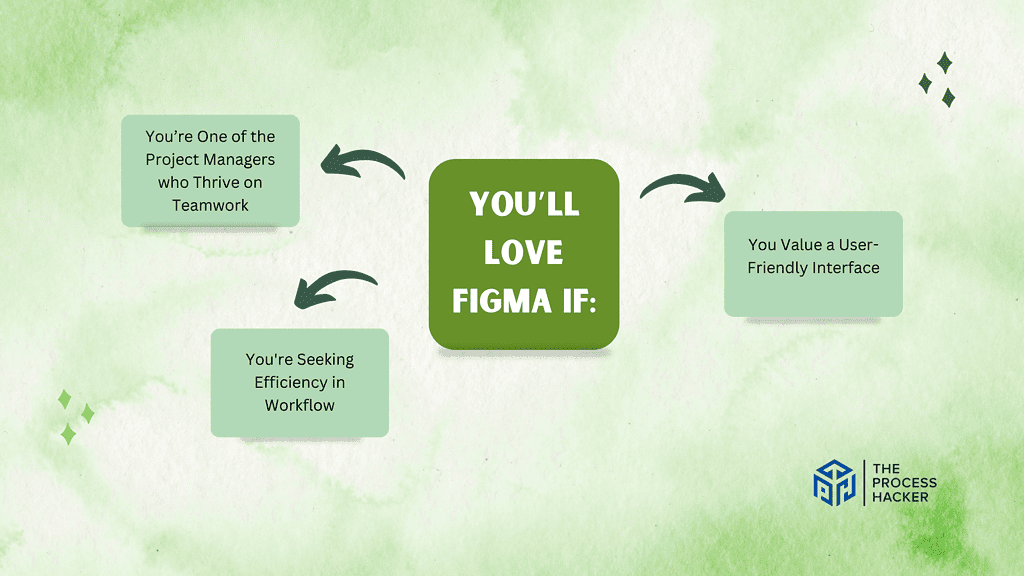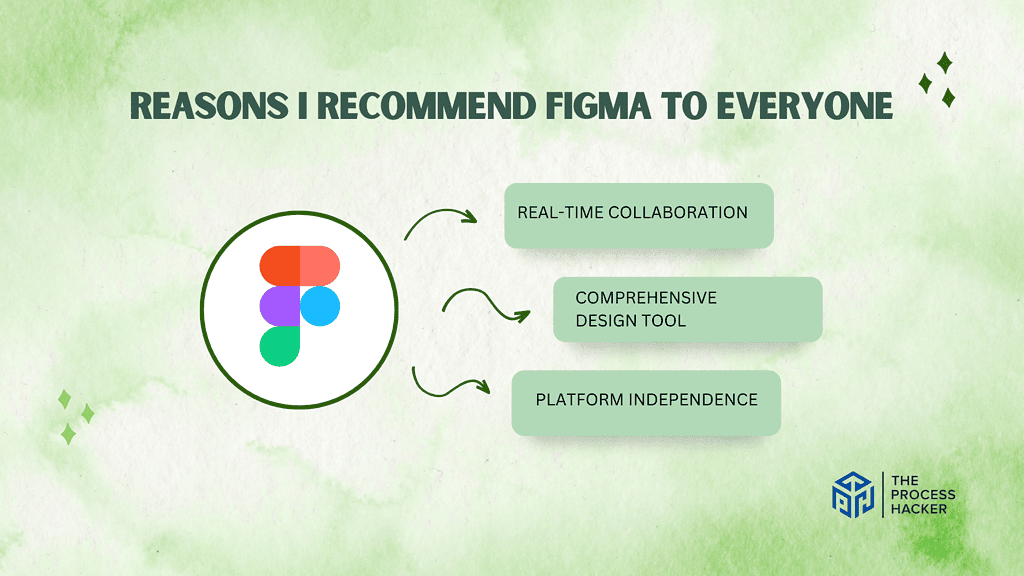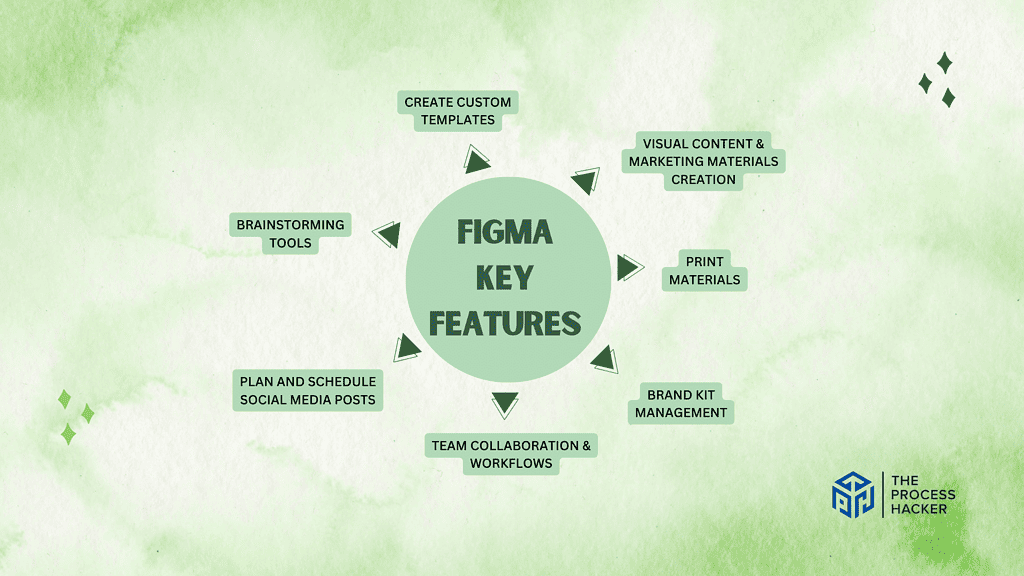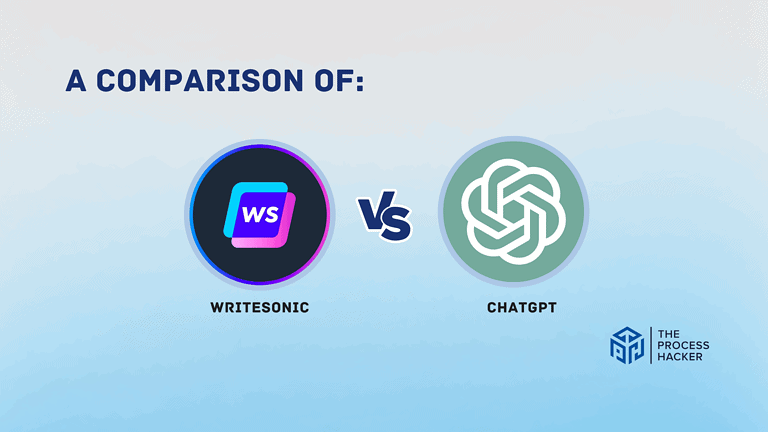Figma Review 2024: Best Design Tool With Collaboration Features?
Are you tired of struggling with design tools that just can’t seem to get the job done?
Frustrated by constantly having to go back and forth with team members, trying to align your visions for a project?
Say goodbye to those problems because Figma is here! This revolutionary design tool not only has all the new features you need for a seamless creative process, but it also includes collaboration features that make working with others a breeze.
If you purchase through our partner links, we get paid for the referral at no additional cost to you! For more information, visit my disclosure page.
Imagine being able to easily share your designs, gather feedback in real-time, and work on projects together without any hassle. With Figma, this dream becomes a reality. Plus, its intuitive interface makes designing feel like second nature.
Ready to elevate your design game? Read this full Figma Review to see if it’s right for you.
Figma Pros & Cons
When considering a design tool with collaboration features, weighing Figma’s pros and cons against your specific needs and preferences is essential to make the right decision.
Pros
Cons
Figma Pros
- Ease of Collaboration: With Figma, you’re stepping into a space where collaboration becomes as easy as sharing a link. No more back-and-forth emails or file transfers. You can work simultaneously with your team, get real-time updates, and make faster decisions.
- Platform Independence: One of the most significant advantages I’ve found is its platform independence. Whether you’re on a Mac, Windows, or even Linux, Figma works seamlessly across all these platforms. This means no more worrying about compatibility issues or software updates while collaborating.
- Built-in Prototyping: Figma has built-in prototyping that allows you to create interactive designs without additional tools. It’s like having a sketch pad that brings your ideas to life, helping you communicate your vision more effectively.
Figma Cons
- Performance with Large Design Files: While Figma handles most design tasks quickly, you may notice lag when working with large files or complex projects. However, this is a common issue with most design tools and can be managed with proper file organization.
- Limited Offline Capabilities: One drawback is its limited offline capabilities. Since Figma is primarily a cloud-based tool, you need a stable internet connection to use its features thoroughly. But, in today’s connected age, this is less of a problem than it might seem.
- Learning Curve: Lastly, like any new tool, there’s a learning curve involved. If you’re switching from another design tool, getting used to Figma’s interface and features might take some time. But don’t worry, there are plenty of tutorials and resources available to help you get up to speed quickly.
Quick Verdict – Is Figma Worth the Money?
After countless hours of using Figma for various projects, yes, it is worth the money!
The key selling point of Figma is its seamless collaboration feature. It’s like having your entire design team working on the same canvas, regardless of their location. The real-time updates and easy sharing eliminate the need for constant emails or file transfers, making the design process smoother and faster.
All these features come with a hefty price tag. Surprisingly, Figma offers a free tier that is quite generous, perfect for individuals or small teams. Their paid plans are competitively priced and offer value for money, considering the enhanced productivity and ease of use.
However, it’s only fair to mention that Figma does have a few minor drawbacks. For instance, it requires a stable internet connection to function optimally due to its cloud-based nature. Also, if you’re working on a larger, more complex project, you may experience some performance issues.
But these are small trade-offs for a tool that significantly enhances your design workflow and fosters better collaboration. So, if you’re looking for a design tool that offers robust features, platform independence, and excellent collaboration capabilities, Figma is worth considering.
If you’re on the fence about Figma, try it free today!
Who is Figma for?
You’ll love Figma if:
- You’re One of the Project Managers who Thrive on Teamwork: If you’re part of a design team or work in an environment where collaboration is key, Figma is your go-to tool. Its real-time collaboration features mean you can work alongside others effortlessly, regardless of your location. Perfect for teams spread across different cities or countries.
- You’re Seeking Efficiency in Workflow: If your goal is to streamline your design process, from ideation to final product, Figma’s all-in-one platform is ideal. It allows you to create, prototype, and share designs all within the same space, reducing the need for multiple tools.
- You Value a User-Friendly Interface: Figma’s intuitive interface will be a breath of fresh air if you prefer tools that don’t require a steep learning curve. Whether you’re a seasoned designer or just starting, you’ll find its interface straightforward.
You won’t love Figma if:
- You Often Work in Offline Environments: Figma might not be the best fit if you frequently find yourself in situations without reliable internet access. Its dependence on internet connectivity for full functionality could be a limiting factor.
- You Prefer Working Solo with Minimal Collaboration: If your workflow is predominantly solitary and you rarely need to collaborate with others on design projects, Figma’s collaboration-focused features might not be as beneficial for you.
- You Enjoy Highly Specialized Design Tools: If you’re a fan of using multiple specialized tools for different aspects of design work, Figma’s all-in-one approach may feel too generalized. Its versatility covers a wide range of design needs but might not match the depth of highly specialized software in certain niche areas.
What is Figma?
Figma is a cloud-based design tool that revolutionizes how you create, prototype, and collaborate on design projects. It’s a versatile platform that seamlessly blends interface design and prototyping, making it an indispensable asset for designers, teams, and organizations.
What is the key benefit of having Figma?
The standout benefit of Figma is its superior collaboration capabilities. You can collaborate directly on the design interface in real-time with others worldwide. This feature not only streamlines the design process but also enhances teamwork and communication, ensuring everyone involved is aligned and up-to-date.
How does Figma work?
Figma operates in the cloud, allowing you to access and work on your projects from any device with internet connectivity. It includes features to create wireframes, prototyping, graphic designing, and developing UI/UX elements.
The tool facilitates seamless feedback and iteration, with commenting and version control options. It has a drag-and-drop interface and various design assets, making it robust and user-friendly.
How is it different from competitors?
Figma sets itself apart with its emphasis on collaboration. While other design tools may offer some form of team interaction, Figma’s real-time collaborative nature is unparalleled.
Additionally, being cloud-based eliminates the need for heavy software downloads and constant updates. Its platform is more accessible and agile than competitors, offering a unique blend of simplicity, power, and teamwork facilitation.
Reasons I Recommend Figma to Everyone
#1) Real-Time Collaboration
One of the most significant benefits of using Figma is collaborating with your team in real-time. This feature has streamlined my workflow and made getting instant feedback from my team incredibly easy. We no longer have to deal with back-and-forth emails or file transfers. Everyone can see the changes as they happen, which speeds up the design process and ensures everyone is on the same page.
I remember working on a project with a tight deadline, and the real-time collaboration feature came in handy. My team and I could simultaneously work on different aspects of a project, making our process much more efficient and time-saving.
#2) Comprehensive Design Tool
The second reason why I recommend Figma is that it’s a comprehensive design tool. From creating wireframes to building interactive prototypes, everything can be done within Figma. It also offers design components that allow for reusing elements across different pages or projects, saving much time.
In one of my recent projects, I created a fully interactive prototype of a business system within Figma. This made it easy to test the flow and functionality of the design before moving into helping the client develop the project. The client was impressed by the interactive demo, which would not have been possible without Figma’s comprehensive features.
#3) Platform Independence
Another reason I love Figma is its platform independence. As I have a team using different devices, it is not a problem. With Figma, we don’t have to worry about software compatibility issues. As long as we have an internet connection, we can access our projects from any device, anywhere.
This feature was handy when I was traveling and trying to collaborate with my team members. I could tweak a board or review my team’s progress from my phone. It’s like having a portable design and collaboration studio at your fingertips.
What You Might Not Like about Figma
#1) Dependency on Internet Connection
While offering many benefits, Figma’s cloud-based model also means that you depend entirely on a solid internet connection. You’ll find working on Figma frustrating if you’re in a location with spotty or slow internet.
There was one instance when I was traveling and had to make some urgent changes to a design. Unfortunately, the Starlink Wi-Fi was unstable, and I struggled to get my work done due to Figma’s constant buffering. It was a stressful experience highlighting the downside of relying entirely on cloud-based tools.
#2) Performance with Large Files
Another area where Figma can improve is its performance with large files. Figma tends to slow down when working on complex projects with multiple pages and components, affecting your productivity.
I experienced this firsthand while working on a large project with numerous pages and components. As the project grew, so did the lag, making it increasingly challenging to work smoothly. While I managed to mitigate the issue to some degree by breaking the project into smaller files, it was an added step that I wish I didn’t have to take.
Figma Pricing
Figma offers a range of pricing options to suit different needs and budgets. For individual designers or small product teams, the Figma Professional plan is available at $15 per month.
For larger organizations seeking advanced features and administrative controls, Figma offers Organization and Enterprise plans, the pricing of which can be tailored to specific needs. This flexible pricing structure ensures that Figma can be an accessible main tool for everyone, from freelancers to large corporations.
Figma: Key Features Breakdown
Let’s break down the key features of Figma and delve into the details of each feature:
Real-Time Collaboration
The real-time collaboration in Figma allows multiple team members to work on a design simultaneously, with everyone’s changes visible in real-time. This feature eliminates the need to send updated files back and forth, making it easier to collaborate and iterate quickly.
What sets this feature apart is that it brings the power of Google Docs-like collaboration to the design world. It’s as if you and your team are sitting in the same room, working on a shared canvas. Each collaborator has their own cursor, and you can see the changes they’re making as they make them.
I recall a project where we were up against a tight deadline. With Figma’s real-time collaboration, my team and I could work together on the design, each focusing on different elements.
Seeing each other’s changes as they happened helped us avoid overlaps and misunderstandings. The result was a more efficient process and a successful project delivered on time.
Vector Networks
Vector Networks is a unique feature that sets Figma apart from other design tools. Unlike traditional pen tools that create paths, Figma’s Vector Networks allow you to create and manipulate lines and shapes in any direction without breaking the user flows of the object. This provides a flexible and intuitive way to create complex vector shapes.
Vector Networks are special because they offer a level of flexibility and control not found in most other design tools. Instead of creating multiple paths, you can create a single, continuous shape that can be easily adjusted and manipulated. This can significantly speed up your workflow and make the design process more efficient.
I remember working on a systems mockup design that involved intricate shapes and paths. With traditional design tools, this would have involved creating multiple separate paths, which would have been time-consuming and challenging to manage.
But I created the entire mockup with Figma’s Vector Networks as a single, continuous shape. This made it much easier to adjust and fine-tune, saving me considerable time and effort.
Prototyping
Prototyping allows you to create interactive mockups of your designs. It’s about connecting various frames and adding interactions to mimic the functionality of an app or website.
Its seamless integration within the design process makes prototyping in Figma unique. There’s no need to export your designs to another tool to build a prototype; it’s all done within Figma itself. This means you can design and prototype concurrently in the same environment, making it easier to iterate and refine your designs based on feedback.
I recall a project where we created a process flowchart for a client. The ability to rapidly construct a working prototype within Figma allowed us to test our concepts early and frequently.
We could pinpoint potential issues and make necessary adjustments much quicker than we would have otherwise. This not only saved us considerable time but also culminated in a superior final product.
Code Generation
Code Generation aids in bridging the gap between design and development. It allows for the conversion of design elements into usable code. You can generate CSS, Swift, or Android XML from your designs with a simple click.
The uniqueness of Code Generation lies in its ease of use and the time it saves in the development process. Instead of manually translating design elements into code, developers can utilize the generated code as a base, making the transition from design to development smoother.
Code Generation helps you control the development without the hardship of poorly understanding the tasks. Your developers can use the generated code as a starting point and tweak it to meet their needs. This will not only reduce the overall project time but also enhance the collaboration between your design and development teams.
Design Systems
Design Systems are a collection of reusable components and standards that help maintain consistency across designs. It includes elements like buttons, color palettes, typography, and more, which can be used across different projects.
The speciality of Figma’s Design Systems lies in its centralized nature. Any changes made to the components in the design system are automatically updated across all designs where they have been used. This ensures consistency and saves time, as you don’t have to manually update each instance.
During a recent project, we had to make a last-minute change to our website’s primary color scheme. Thanks to Figma’s Design Systems, the change was propagated throughout the entire project almost instantly.
Without Figma, we would have had to manually change every single element, which would have been time-consuming and prone to errors. The Design Systems feature not only saved us time but also ensured that our designs remained consistent.
Plugins and Integrations
Plugins and Integrations are additional tools or services that can be incorporated into your design process to extend the functionality of the platform. They range from utilities that automate repetitive tasks to integrations with project management tools to plugins that help generate content.
With just a few clicks, you can add powerful functions to your workflow tailored to your specific needs. This flexibility makes Figma more than just a design tool; it becomes a comprehensive solution that adapts to your workflow.
For instance, during a project that required designing multiple user personas, we utilized a plugin that automatically generated avatars and personal details. This saved us hours of manual work and allowed us to focus on the core design aspects.
Furthermore, integrating Figma with our preferred project management tool made it easier for our team to track progress and collaborate effectively. The Plugins and Integrations feature in Figma has not only made my work more efficient but also enriched the overall design process.
Animation and Micro-Interaction
Animation and Micro-Interaction allow you to create and demonstrate small-scale animations within the design interface. This feature enables designers to smartly animate transitions between different states of a component, simulate hover effects, load spinners, button clicks, and more.
What sets this feature apart is how it enhances the user experience. By using animations and micro-interactions, designers can create more engaging interfaces and provide more intuitive feedback to user actions. It breathes life into static designs, giving users a taste of how the final product will look and feel.
During a recent project, I used these features to demonstrate the flow and interaction of a business process to my client. This helped them understand and visualize the user experience better than any static design could.
Furthermore, it allowed me to try the different interactions and animations in real-time, significantly improving the design process. This feature has truly elevated the way I present and improved my process and system designs.
FAQs about Figma
Is there a community for Figma enthusiasts?
Indeed, there is a vibrant community forum for Figma where you can connect with, learn from, and share with other designers. It’s a rich resource for obtaining tips, troubleshooting problems, and discovering innovative ways to use Figma.
Can I use Figma offline?
While Figma primarily operates as a cloud-based tool, it does offer some offline functionality. You can continue to work on Figma files that are currently open in your Figma desktop app, even if you lose internet connection. However, changes will only sync with the server once you return online.
Is Figma easy to learn for beginners?
Absolutely! Figma is designed with user-friendliness in mind. Its intuitive interface and well-organized tools make it easy to pick up, even for those new to the design field. Plus, plenty of tutorials and resources are available online to help you get started.
How secure is Figma?
Figma takes security seriously. All data transferred between users and Figma servers is encrypted, and regular audits are conducted to ensure security standards are maintained. So, you can rest assured that your designs are protected.
Can I import my Sketch files into Figma?
Yes, you can. Figma allows you to import Sketch files directly, making it easy for you to transition your projects from Sketch to Figma without losing any of your work.
Can I export my designs from Figma?
Definitely, Figma supports exporting designs in various formats like PNG, JPG, SVG, and PDF, among others. This makes it easy to share your designs with others, even if they don’t have a Figma account.
Final Verdict – to Buy Figma or Not to Buy Figma?
After thoroughly analyzing Figma and its features, I strongly recommend trying Figma for your design and collaboration needs.
Figma’s robust features, such as real-time collaboration tools, the ability to create interactive components, and extensive team libraries of templates, make it a powerful tool in the design process.
It has reinvented how teams can work together on design projects, eliminating the barriers of distance and time zones. Its pricing plans are flexible enough to cater to individuals, small teams, and large enterprises.
Now, you may be wondering about its learning curve, especially if you’re new to the design field. Fear not; Figma’s user-friendly interface and the wealth of online tutorials available make it relatively easy for beginners to get started. Plus, their responsive community forum is always there to help you with any issues you encounter.
As for security concerns, rest assured that Figma prioritizes protecting your data with encryption and regular audits.
So, go ahead and give Figma a try. You’ll find your design workflow transformed for the better.
Now, if you aren’t entirely convinced by the Figma reviews, in the next section, we’ll explore some alternatives to Figma that might better align with your requirements.
Figma Alternatives
If $15 per month or more is too much for you to stomach right now, or you need a different solution, you might like one of these alternatives.
#1) Adobe XD
Adobe XD, part of the Adobe Creative Suite, stands out as a strong competitor to Figma. Its key difference lies in its seamless integration with other Adobe products like Photoshop and Illustrator, making it a great choice if you’re already embedded in the Adobe ecosystem.
While Figma excels in real-time collaboration, Adobe XD provides a more advanced prototyping tool and animation capabilities. It’s superior for you if you value intricate animations and transitions in your designs. Adobe XD is also a better fit for individuals or teams already using Adobe products, ensuring a smooth workflow across various designs with essential tools.
#2) Sketch
Sketch, exclusively available for macOS, is another noteworthy alternative. The main distinction between Sketch and Figma is Sketch’s macOS exclusivity, making it an ideal choice if you’re a dedicated Mac user.
Sketch’s interface is renowned for its simplicity, and its vast library of plugins allows for extensive customization. However, unlike Figma, Sketch lacks a robust real-time collaboration feature, making it more suitable for individuals or small teams.
Sketch shines in its ease of use and powerful vector editing tools. It’s especially preferred by designers who focus on high-fidelity UI design and those who appreciate the macOS ecosystem.
#3) Canva
Canva is an intuitive graphic design system that allows non-designers to create eye-catching visuals and graphics. From business presentations to social media posts, Canva makes designing easy and accessible.
On the other hand, Figma has incredible collaboration tools for design. Unlike Canva, Figma is more focused on interface design and offers more advanced features for professionals who need to work with coding, prototyping, and animations.
Whether you’re a designer, marketer, or developer, both Canva and Figma have something to offer when it comes to creating robust designs to elevate your brand.











